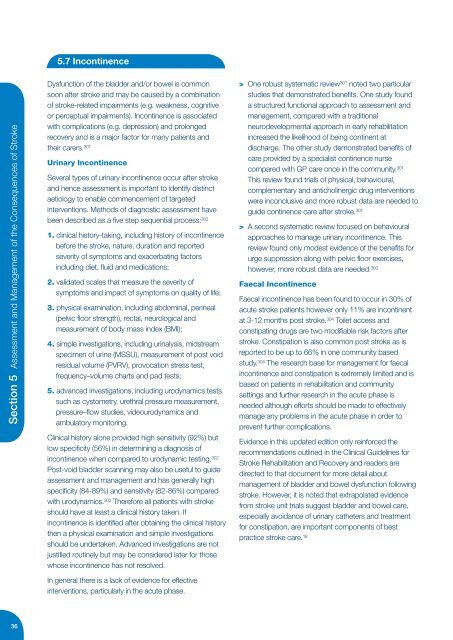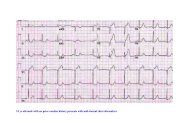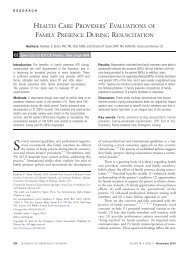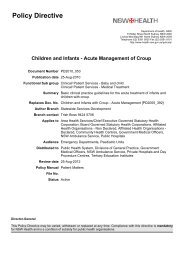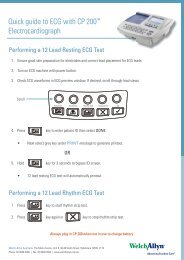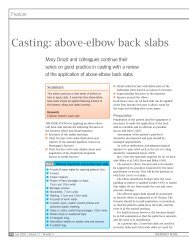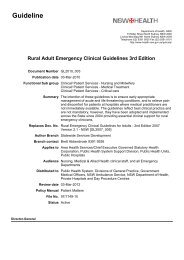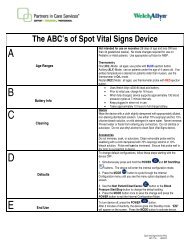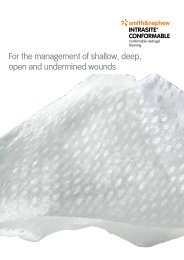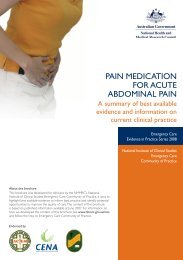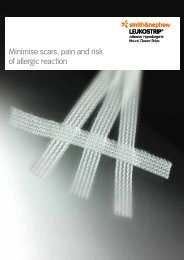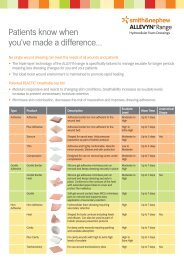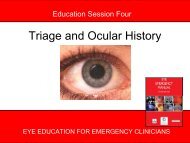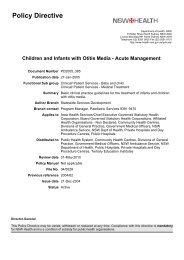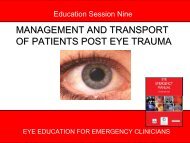Clinical Guidelines for Acute Stroke Management - Living on the EDge
Clinical Guidelines for Acute Stroke Management - Living on the EDge
Clinical Guidelines for Acute Stroke Management - Living on the EDge
You also want an ePaper? Increase the reach of your titles
YUMPU automatically turns print PDFs into web optimized ePapers that Google loves.
5.7 Inc<strong>on</strong>tinence<br />
Secti<strong>on</strong> 5 Assessment and <str<strong>on</strong>g>Management</str<strong>on</strong>g> of <strong>the</strong> C<strong>on</strong>sequences of <str<strong>on</strong>g>Stroke</str<strong>on</strong>g><br />
Dysfuncti<strong>on</strong> of <strong>the</strong> bladder and/or bowel is comm<strong>on</strong><br />
so<strong>on</strong> after stroke and may be caused by a combinati<strong>on</strong><br />
of stroke-related impairments (e.g. weakness, cognitive<br />
or perceptual impairments). Inc<strong>on</strong>tinence is associated<br />
with complicati<strong>on</strong>s (e.g. depressi<strong>on</strong>) and prol<strong>on</strong>ged<br />
recovery and is a major factor <str<strong>on</strong>g>for</str<strong>on</strong>g> many patients and<br />
<strong>the</strong>ir carers. 301<br />
Urinary Inc<strong>on</strong>tinence<br />
Several types of urinary inc<strong>on</strong>tinence occur after stroke<br />
and hence assessment is important to identify distinct<br />
aetiology to enable commencement of targeted<br />
interventi<strong>on</strong>s. Methods of diagnostic assessment have<br />
been described as a five step sequential process: 302<br />
1. clinical history-taking, including history of inc<strong>on</strong>tinence<br />
be<str<strong>on</strong>g>for</str<strong>on</strong>g>e <strong>the</strong> stroke, nature, durati<strong>on</strong> and reported<br />
severity of symptoms and exacerbating factors<br />
including diet, fluid and medicati<strong>on</strong>s;<br />
2. validated scales that measure <strong>the</strong> severity of<br />
symptoms and impact of symptoms <strong>on</strong> quality of life;<br />
3. physical examinati<strong>on</strong>, including abdominal, perineal<br />
(pelvic floor strength), rectal, neurological and<br />
measurement of body mass index (BMI);<br />
4. simple investigati<strong>on</strong>s, including urinalysis, midstream<br />
specimen of urine (MSSU), measurement of post void<br />
residual volume (PVRV), provocati<strong>on</strong> stress test,<br />
frequency–volume charts and pad tests;<br />
5. advanced investigati<strong>on</strong>s, including urodynamics tests<br />
such as cystometry, urethral pressure measurement,<br />
pressure–flow studies, videourodynamics and<br />
ambulatory m<strong>on</strong>itoring.<br />
<str<strong>on</strong>g>Clinical</str<strong>on</strong>g> history al<strong>on</strong>e provided high sensitivity (92%) but<br />
low specificity (56%) in determining a diagnosis of<br />
inc<strong>on</strong>tinence when compared to urodynamic testing. 302<br />
Post-void bladder scanning may also be useful to guide<br />
assessment and management and has generally high<br />
specificity (84-89%) and sensitivity (82-86%) compared<br />
with urodynamics. 302 There<str<strong>on</strong>g>for</str<strong>on</strong>g>e all patients with stroke<br />
should have at least a clinical history taken. If<br />
inc<strong>on</strong>tinence is identified after obtaining <strong>the</strong> clinical history<br />
<strong>the</strong>n a physical examinati<strong>on</strong> and simple investigati<strong>on</strong>s<br />
should be undertaken. Advanced investigati<strong>on</strong>s are not<br />
justified routinely but may be c<strong>on</strong>sidered later <str<strong>on</strong>g>for</str<strong>on</strong>g> those<br />
whose inc<strong>on</strong>tinence has not resolved.<br />
In general <strong>the</strong>re is a lack of evidence <str<strong>on</strong>g>for</str<strong>on</strong>g> effective<br />
interventi<strong>on</strong>s, particularly in <strong>the</strong> acute phase.<br />
> One robust systematic review 301 noted two particular<br />
studies that dem<strong>on</strong>strated benefits. One study found<br />
a structured functi<strong>on</strong>al approach to assessment and<br />
management, compared with a traditi<strong>on</strong>al<br />
neurodevelopmental approach in early rehabilitati<strong>on</strong><br />
increased <strong>the</strong> likelihood of being c<strong>on</strong>tinent at<br />
discharge. The o<strong>the</strong>r study dem<strong>on</strong>strated benefits of<br />
care provided by a specialist c<strong>on</strong>tinence nurse<br />
compared with GP care <strong>on</strong>ce in <strong>the</strong> community. 301<br />
This review found trials of physical, behavioural,<br />
complementary and anticholinergic drug interventi<strong>on</strong>s<br />
were inc<strong>on</strong>clusive and more robust data are needed to<br />
guide c<strong>on</strong>tinence care after stroke. 301<br />
> A sec<strong>on</strong>d systematic review focused <strong>on</strong> behavioural<br />
approaches to manage urinary inc<strong>on</strong>tinence. This<br />
review found <strong>on</strong>ly modest evidence of <strong>the</strong> benefits <str<strong>on</strong>g>for</str<strong>on</strong>g><br />
urge suppressi<strong>on</strong> al<strong>on</strong>g with pelvic floor exercises,<br />
however, more robust data are needed. 303<br />
Faecal Inc<strong>on</strong>tinence<br />
Faecal inc<strong>on</strong>tinence has been found to occur in 30% of<br />
acute stroke patients however <strong>on</strong>ly 11% are inc<strong>on</strong>tinent<br />
at 3-12 m<strong>on</strong>ths post stroke. 304 Toilet access and<br />
c<strong>on</strong>stipating drugs are two modifiable risk factors after<br />
stroke. C<strong>on</strong>stipati<strong>on</strong> is also comm<strong>on</strong> post stroke as is<br />
reported to be up to 66% in <strong>on</strong>e community based<br />
study. 304 The research base <str<strong>on</strong>g>for</str<strong>on</strong>g> management <str<strong>on</strong>g>for</str<strong>on</strong>g> faecal<br />
inc<strong>on</strong>tinence and c<strong>on</strong>stipati<strong>on</strong> is extremely limited and is<br />
based <strong>on</strong> patients in rehabilitati<strong>on</strong> and community<br />
settings and fur<strong>the</strong>r research in <strong>the</strong> acute phase is<br />
needed although ef<str<strong>on</strong>g>for</str<strong>on</strong>g>ts should be made to effectively<br />
manage any problems in <strong>the</strong> acute phase in order to<br />
prevent fur<strong>the</strong>r complicati<strong>on</strong>s.<br />
Evidence in this updated editi<strong>on</strong> <strong>on</strong>ly rein<str<strong>on</strong>g>for</str<strong>on</strong>g>ced <strong>the</strong><br />
recommendati<strong>on</strong>s outlined in <strong>the</strong> <str<strong>on</strong>g>Clinical</str<strong>on</strong>g> <str<strong>on</strong>g>Guidelines</str<strong>on</strong>g> <str<strong>on</strong>g>for</str<strong>on</strong>g><br />
<str<strong>on</strong>g>Stroke</str<strong>on</strong>g> Rehabilitati<strong>on</strong> and Recovery and readers are<br />
directed to that document <str<strong>on</strong>g>for</str<strong>on</strong>g> more detail about<br />
management of bladder and bowel dysfuncti<strong>on</strong> following<br />
stroke. However, it is noted that extrapolated evidence<br />
from stroke unit trials suggest bladder and bowel care,<br />
especially avoidance of urinary ca<strong>the</strong>ters and treatment<br />
<str<strong>on</strong>g>for</str<strong>on</strong>g> c<strong>on</strong>stipati<strong>on</strong>, are important comp<strong>on</strong>ents of best<br />
practice stroke care. 18<br />
36


